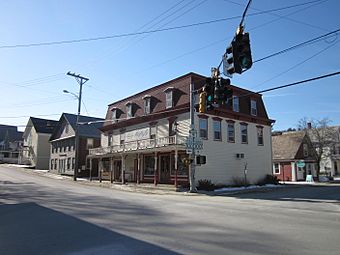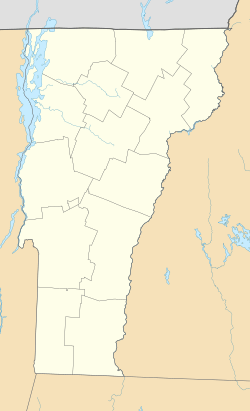Wilmington Village Historic District facts for kids
Quick facts for kids |
|
|
Wilmington Village Historic District
|
|
 |
|
| Location | VT 9 and VT 100, Wilmington, Vermont |
|---|---|
| Area | 45 acres (18 ha) |
| Architectural style | Greek Revival, Late Victorian, Colonial Revival |
| NRHP reference No. | 80000389 |
| Added to NRHP | August 11, 1980 |
The Wilmington Village Historic District is a special area in Wilmington, Vermont. It's like a time capsule showing how the village looked long ago. This district was added to the National Register of Historic Places in 1980. This means it's an important place recognized for its history.
Contents
What Makes Wilmington Village Special?
Where is Wilmington Village Located?
Wilmington village is in southern Windham County, Vermont. It sits where two main roads meet: Vermont Route 9 and Vermont Route 100. Route 9 goes east and west across southern Vermont. Route 100 travels north and south along the Green Mountains.
These roads meet near the North Branch Deerfield River. The river was very important in the past. It provided power for the village's businesses and factories.
What Buildings Are in the Historic District?
The historic district covers a large area of the village. It stretches along Route 9 and Route 100. There are 59 buildings in the district that are historically important. Only five buildings are not considered historic.
Most of these buildings were built in the 1800s. They show popular building styles from that time. Some special buildings include the Crafts Inn and Memorial Hall. These were built around 1900.
How Did Wilmington Village Begin?
Early Days of Wilmington
The town of Wilmington was officially started in 1757. But there was a mix-up with another charter in 1764. This caused delays in the town's growth until the 1770s.
The very first town center was on top of Lisle Hill. This is northeast of where the village is now. But the town center moved. It moved because the river and important travel routes met in the current village spot. This made it a better place for businesses to grow.
Some of the buildings from the old town center were even moved to the new location! A major road, which became Route 9, was built through the area in 1831. In the past, many mills lined the river, using its power. None of those original mills are still standing today.



